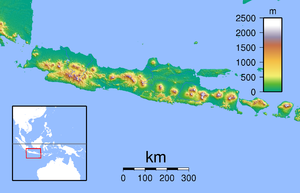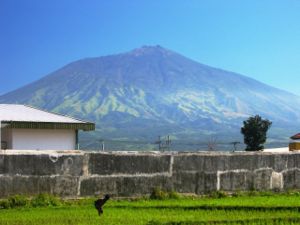- Malang
-
- For the Filipino illustrator and painter, see Malang (painter).
Malang Malang town hall Motto: Malang Kucecwara Location of Malang in Indonesia Location of Malang in Indonesia Coordinates: 7°58′48″S 112°37′12″E / 7.98°S 112.62°ECoordinates: 7°58′48″S 112°37′12″E / 7.98°S 112.62°E Country Indonesia Province East Java Government - Mayor Drs. Peni Suparto, MAP Area - Total 252.13 km2 (97.3 sq mi) Population (2010 Census) - Total 819,708 Time zone WIB (UTC+7) Area code(s) +62341 Website http://www.malangkota.go.id/ Malang is the second largest city in East Java province, Indonesia. It has an ancient history dating back to the Mataram Kingdom. The city population at the 2010 Census was 819,708. During the period of Dutch colonization, it was a popular destination for European residents. The city is famous for its cool air and the surrounding country regions of Tumpang, Batu, Singosari, and Turen. People in East Java sometimes call it "Paris of East Java." Malang was spared many of the effects of the Asian financial crisis, and since that time it has been marked by steady economic and population growth.
Contents
Etymology
The name of Malang is taken from a temple namely Malang Kucecwara. The name of the temple is now applied to the motto of Malang. Malang Kucecwara literally means God has destroyed the false and enforced the right. Location of the temple is supposesedly located near modern Malang. "Malang" is Javanese word for "menghalangi (Indonesian)" or impeded (English). That word comes from the traditional historical stories that people of Malang fought bravely against the invaders from the Mataram Sultane .
History
Hundreds, even thousands of years ago before Malang became the second biggest city in East Java, Malang used to be the centre of government of the Kanjuruhan and Singhasari Kingdom. In the following era, Malang regency became an important place when the government of Mataram Kingdom took hold of the area, making it the largest regency in East Java and since then the development of Malang regency has increased well.
The history of Malang Regency could be revealed through the Dinoyo inscription 760 AD as the primary official document to support the birth of Malang before a new inscription was discovered in 1986, which is so far not yet revealed. According to the inscription, it was concluded that the 8th century was the beginning of the existence of Malang Regency's government due to the birth of King Gajayana's ruling of his kingdom in Malang. From the Dinoyo inscriptions, it is noted that the inscription used the "Candra Sengkala" or "Cronogram" Calendar, and stated that the birth date of Malang Regency was on Jum'at Legi (sweet Friday) 28 November 760 AD. (L. Damaes: "Studed' Epigraphy d'Indonesia IV. 1952").
The city was incorporated into Mataram in 1614, then transferred to Dutch colonial rule. Malang was transformed under the Dutch; its cool climate which results from its elevation, along with its proximity to the major port of Surabaya, made it a popular destination for Dutch and other Europeans. In 1879, Malang was connected to Java's railroad network, further increasing development and leading to increased industrialization.
Along with growth came urbanization. The government could not satisfy the population’s needs for affordable housing, which lead to the building of shanty towns along the rivers and rail tracks. Up until today, the shanty towns still exist; although some have been transformed into “better” housing.
Geography
Malang has a total area of 252.136 km2. It shares its borders with Pasuruan Regency (North), Lumajang Regency (East), and Batu City (West). Mount Bromo, one of Java's largest volcanoes and a major tourist attraction, is located just to the east of the city. Malang is served by the Abdul Rachman Saleh Airport, a domestic airport with flights to Jakarta.
Subdistricts
Malang is divided into five subdistricts:
- Blimbing
- Kedungkandang
- Klojen
- Lowokwaru
- Sukun
Demographics
There are roughly 1,175,282 people living in Malang. The population density is 10,000 – 200/km2, with population growth of 9.3% per year.
Ethnic backgrounds
The racial makeup of the city is mainly of Javanese and Madura, with a small percentage of the Arabic and Chinese descendants. There is no apparent racial discimination against minority Chinese descendants.
Religion
Like most of Java, a large majority of Malang residents are Muslim; there are small minorities of Catholics, Hindus, and Buddhists. Many buildings of worship still stand from their construction in the colonial era. For example, City of Malang Grand Mosque or Masjid Agung Kota Malang in Malang City Square or Alun-alun kota Malang; Church of the Sacred Heart of Jesus (Gereja Hati Kudus Yesus) in Kayutangan; Saint Mary from Mount Carmel Cathedral (Gereja Ijen or Katedral Santa Maria dari Gunung Karmel) in Ijen Street, which is the seat for the Roman Catholic Diocese of Malang; the Immanuel Church in Alun-alun; and Eng An Kiong Buddhist Temple in JL. Laksamana Martadinata No 1 Malang. Malang is also famous for being the centre of religious education, this is evident with the existence of many Islamic schools (pesantren) and bible seminars.
Language
Javanese is the day-to-day language used by Malang people. Many of the native Malang youths adopt a dialect that is called 'boso walikan', it is simply done by reversing the pronunciation of the words, an example of this is by pronouncing “Malang” as “Ngalam” instead. Like Surabaya, Malang residents adopt an egalitarian form of Javanese. As it becomes the educational city, there are many languages from outside Java spoken in Malang.
Art & Culture
As a centre of tourism, Malang has various places of interest which can be classified into local, regional, national and international standards, including traditional dance performances such as Tari Topeng (Mask Dance), Jaran Pegon, Tari Beskalan (Beskalan Dance), etc. There are also 'Topeng' or Mask handicraft at the villages of Jabung and Kedungmonggo which have become a familiar landmark in Malang Regency.
Malang is also home to a thriving transgender (waria) community headed by Miss Waria Indonesia 2006, Merlyn Sopjan.[1]
Non-residents
Temporary residents to Malang are mostly for educational reasons. They come from other islands especially from East of Indonesia, which includes Bali, Nusa Tenggara, East Timor, Papua, Maluku, Sulawesi and Kalimantan.
Education
Colleges and schools in Malang include University of Brawijaya (UB), State Polytechnic of Malang (Polinema), Malang State University (UM), STIE Malangkucecwara, University of Muhammadiyah Malang (UMM), Malang State Islamic University of Maulana Malik Ibrahim (UIN Maliki), Institut Teknologi Nasional Malang (ITN) Merdeka University (Unmer), VEDC (Vocational and Educational Development Center), SMUK Kolese Santo Yusup, SMAK St. Albertus, SMAN 1, SMA Negeri 3 Malang, 4 Malang, SMU Negeri 8 Malang, SMA Negeri 7 Malang, SMA Negeri 2 Malang. Malang also has two international schools, Wesley International School and Bina Bangsa School, and some national-plus schools, such as Charis National Academy, Catholic Elementary School [http://sdksantamaria2.sch.id/ SD Katolik Santa Maria II Malang IKIP Budi Utomo Malang
Transport
Road
Malang is located in Indonesian National Route 23, which connects it to Gempol and Kepanjen. Malang has a large intercity bus terminal, Arjosari, located in northern Malang. The primary means of public transportation is by minibus, called angkot (from angkutan=transportation and kota=city). They serve certain routes throughout the city, operated privately and cheap, but these city shuttles are not usually known for being comfortable.
Train
The largest train station in Malang is Malang Station. The station is frequently called "Kotabaru Station", to distinguish it from Kotalama Station located in the south. Another train station is Blimbing, located in the north. Previously, there was a tram system in Malang, now defunct.
Air
Malang is served by Abdul Rachman Saleh Airport, located in the outskirts of Malang. This airport can be accessed by taxis and travels.
Sport
Persema Malang, Arema Indonesia plays in the Indonesian top league, the Indonesia Super League (ISL). The suporter called Aremania
Sidoarjo mud flow
On 28 May 2006, a blow-out occurred during a drilling for an exploration of Natural Gas. The blow-out initially produced 5000 m³ of mud flow per day. 18 months after the incident, the mud flow is estimated to be 80,000 m³ to 100,000 m³ per day. This ongoing mud flow has forced the closure of the Porong-Gempol toll road in East Java, which effectively cut off the transport line from Surabaya to Malang.[2]
References
- ^ Kim Heriot-Darragh. "Transgendered in Malang". Inside Indonesia. http://insideindonesia.org/content/view/606/47/.
- ^ Jim Schiller. "Un-natural disaster". Inside Indonesia. http://insideindonesia.org/content/view/1020/47/.
External links
- Malang travel guide from Wikitravel
- Official website (Indonesian)
Regencies and cities of East Java (Jawa Timur) Capital: Surabaya Regencies
Banyuwangi • Bangkalan • Blitar • Bojonegoro • Bondowoso • Gresik • Jember • Jombang • Kediri • Lamongan • Lumajang • Madiun • Magetan • Malang • Mojokerto • Nganjuk • Ngawi • Pacitan • Pamekasan • Pasuruan • Ponorogo • Probolinggo • Sampang • Sidoarjo • Situbondo • Sumenep • Trenggalek • Tuban • Tulungagung

Cities
See also: List of regencies and cities of Indonesia Categories:- Populated places in East Java
- Regencies of East Java
- Malang
- Cities in Indonesia
- Regency capitals of Indonesia
Wikimedia Foundation. 2010.





